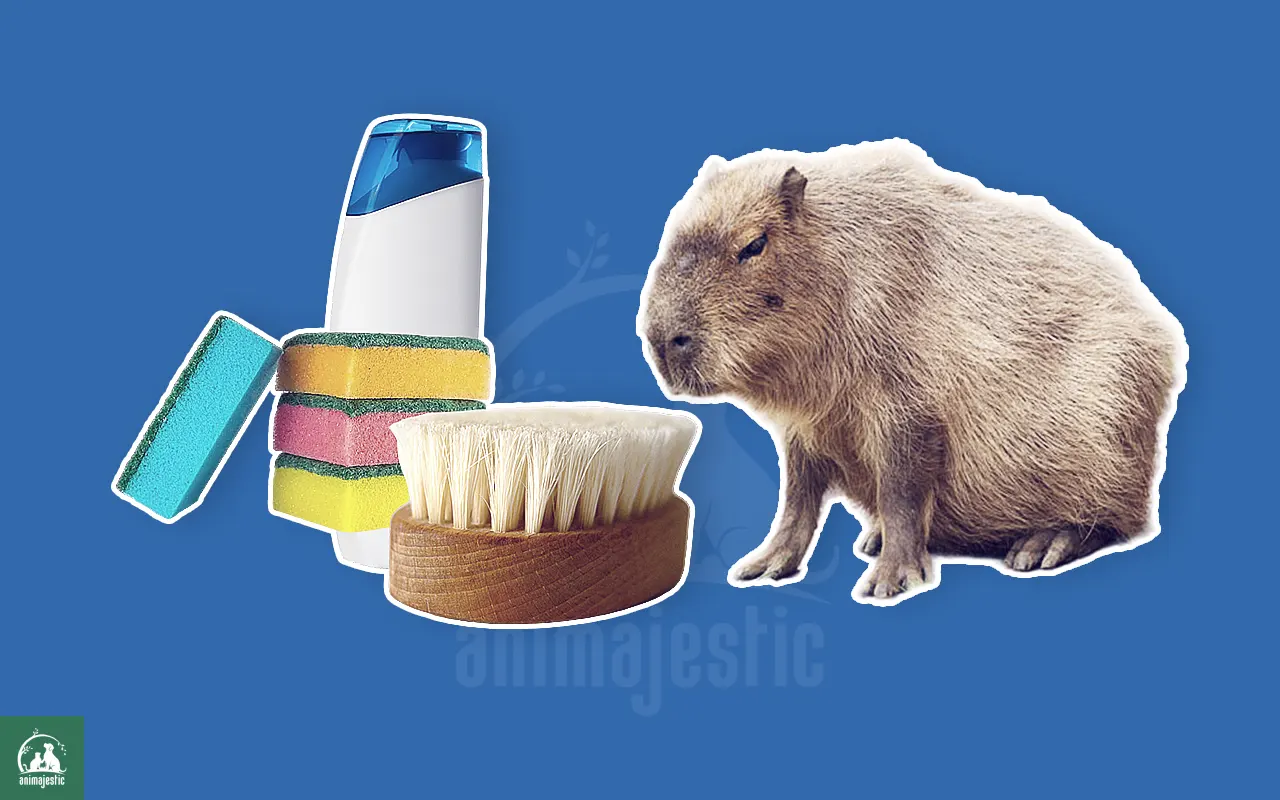Bathing and grooming Capybaras should not be underestimated, it is an essential aspect of their overall well-being and happiness which involves more than just cleaning these gentle semi-aquatic mammals.
The process requires a thoughtful approach, attentiveness, and knowledge of the specific needs and behavioral characteristics of Capybara.
This introduction will provide you with a glimpse into the often overlooked, but immensely rewarding activity of bathing and grooming capybaras.
So, whether you work in an animal care facility or a zoo, or you are fortunate to have a capybara at home, you’ll find these tips useful to ensure your capybara friend’s health and happiness.
As sweet as it is to form a bond with a Capybara, the responsibility of having one increases tenfold, especially when one thinks about grooming and bathing. It’s not as easy as petting a cat or walking a dog, so let’s dive into an in-depth discussion on this topic.
NOTE: Before owning a Capybara, make sure to check your local laws and regulations regarding the possession of exotic pets.
Why the Emphasis on Bathing and Grooming Capybaras?
Understanding why we must focus so intently on bathing and grooming these creatures could significantly affect how you approach the process.
Capybaras thrive near water bodies in the wild that serve multiple purposes, including maintaining their body temperature, hiding from predators, and of course, self-cleaning.
Therefore, apart from an inherent love for water, these animals possess a physiological need for moisture. The dry skin conditions they quickly develop when deprived of water should also not be neglected.
Personal Protective Measures
Before we start to explore the grooming ritual, it’s crucial to understand the need for personal protective measures. Wear a waterproof apron to prevent getting soaked while bathing them. Non-latex gloves could also be a good idea to protect against possible scratches or bites.
Setting Up a Capybara-Friendly Bath
Capybaras are naturally drawn to water, and creating a safe and welcoming bath environment will ensure their comfort.
- Safety: Be it a small pool or a bathtub, having a non-slip surface is crucial to prevent slipping.
- Depth: The depth of the water should be such that the Capybara can easily tread the water and keep its snout out for breathing.
- Water Temperature: Capybaras thrive in warm water, around the 75°F – 85°F range. Hence the water temperature should be maintained within this range to put them at ease.
Bathing Ritual for Capybaras
While bathing, use a gentle, mild pet shampoo or soap that won’t irritate their skin or eyes. Also, be sure to check if the product is safe for exotic animals.
Here are the steps:
Step 1: Getting Capybara Into the Bath
Capybaras might be reluctant to the introduction of a new bathing area, but with time, they get accustomed to the process. Lure them to the bathing area with their favorite fruits or veggies, and let them explore the water body calmly.
Step 2: Applying Shampoo
Using a very light touch, massage the shampoo into their fur. Ensure you keep it away from their ears and eyes. A small, fine-toothed comb can aid in removing matted hair or specks of dirt.
Step 3: The Rinse
After a good scrub, it’s time to rinse off the shampoo. Use a handheld shower head or a large cup to pour water over its body. Be patient and ensure all the shampoo is thoroughly rinsed away.
Step 4: Drying Off
Capybaras should be dried promptly after a bath to avoid catching a cold. Use a towel to gently pat dry (never rub) and let them air dry under a heat lamp or in a warm, draft-free space.
Grooming Capybaras – More Than Just Baths
Capybara grooming is more than just baths. Their teeth, nails, and hair all require careful attention.
- Teeth-Grooming: Capybaras have continuously growing teeth, a trait shared by all rodents. If their teeth become overgrown, it can lead to serious oral health issues. Hence, providing chewable items like untreated wood or a specific rodent-safe chewing toy is imperative.
- Nail-Trimming: The nails of a Capybara need to be cut regularly to ensure they do not face difficulty while walking or end up with a painful ingrown nail. A professional groomer or vet tech can also help with this task.
- Hair Brushing: Brushing their fur not only helps keep them looking their best, but it’s also an essential bonding activity that can be done weekly.
General Hygiene
Your Capybara’s surrounding environment needs to be kept clean.
Spot-cleaning their living quarters daily is necessary to prevent any kind of infections or infestations.
Always monitor for changes in behavior, posture, or appearance that could indicate a potential health issue.
Final Thought
Caring for a Capybara with patience, dedication, and love will ensure they live a healthy, comfortable life. Learn as much as you can from valid sources and always be open to seeking help from professionals when necessary.
Grooming and bathing should become enjoyable for both you and your Capybara – forming a bond that is beautiful, fascinating, and enriching.
